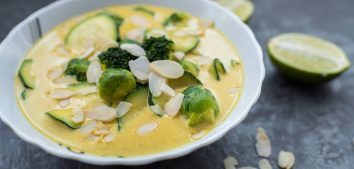
Proteins
The most essential functions of proteins (a simplified list): building blocks for tissues and enzymes, hormones and other compounds essential…
The most essential functions of proteins (a simplified list):
- building blocks for tissues and enzymes, hormones and other compounds essential for life
- determine appropriate growth and development of a human
- determine tissue regeneration
- distribute nutrients, medicines and respiratory gases in body fluids throughout the body
- ensure intracellular transport
- constitute a basic part of the immune system – antibodies are proteins
- regulate the amount of liquids in every part of the body
- support maintaining acid-base balance
Our body is actually built of proteins, but we have to continually provide our bodies with them, because they are subjected to the constant process of breaking down and regeneration. The quality of this process depends on amino acids of which proteins are built. Part of amino acids need to be supplied in the diet, as the body cannot produce them itself. Such amino acids are called exogenous. Isoleucine, leucine, lysine, methionine, phenylalanine, threonine, tryptophan and valine belong to this group. Serine and arginine are those which are produced by the organism, however, when we feel stressed or ill the body fails to produce enough of them, so it is essential to supply those amino acids in the diet. I am writing here about amino acids not without reason. In fact, the nutritious value of proteins in the diet depends, to a great extent, on the number and type of amino acids that are the building blocks of proteins. Apart from that, what also decides on the nutritious value of proteins are digestibility and energy they provide. FAO and WHO experts decided that the models to make comparisons of nutritious values in protein food are breast milk and hen egg, because the proteins they contain are the most effectively used by the body. There are a lot of methods to mark the values of proteins and it would be difficult to describe in this publication even a few of them. Especially because scientists have arguments over proteins. All the details in question here concern the basics of nutrition.
Meat
A lot of publications claim that the main source of dietary protein is meat, treating cereal and vegetable proteins as less valuable. Nevertheless, the number of vegetarian diet supporters is still growing, even among scientists themselves. To prove they are right, they present results of their research. They claim that despite the fact that meat contains desirable for the body protein, it can be replaced with proteins coming from dairy and cereal products, vegetables or nuts. They call for eliminating meat from the diet showing its harmful effects to the human body as well as development atherosclerosis and tumours. I have not eliminated meat from my menu. I know that there are vegetarians or even vegans among sportspeople, but my knowledge about protein demand during intensive workouts makes me treat animal protein as a regular, but not dominating part of my diet. Of course, I care about a good source of protein. I do not buy or eat cold meats and other meat products, because in the production process such meat loses essential components. It is “enriched” in substances harmful to my health instead. I do not eat pork, only lean beef and poultry. I willingly eat Oily fish, because it does not only contain protein but also Omega 3 among other things. I do not mind vegetarian diet though. Its supporters should be well aware of what their organisms are deprived of when meat is not included in the diet. They should pay attention to deliver all the necessary nutrients for life in the form of other foods.
Milk
As I have already written, breast milk is considered to be a standard of well-absorbed protein. If a mother eats healthily, her milk is the best food for her baby. It contains lactose that takes care of the normal bacterial flora in the colon. Breast milk contains omega-3,6 and 9 fatty acids in the right proportions, conditioning the proper development of intellect. It also contains a lot of other constituents that are essential for the healthy and proper growth of a baby. Unfortunately, cow’s milk differs from human milk. This is so because cow’s milk contains too much casein – a protein that is needed only in the initial period of life. Casein is digested thanks to rennet – an enzyme which is produced only in infancy. Cow’s milk is heavy even for infants. In adults it causes putrefaction processes in intestines and faecal impaction. Supporters of cow’s milk emphasize its role in supplying good calcium to the body. However, calcium can be also found in vegetables, eggs, fruit, bran and nuts, which contain minerals that enable calcium absorption. Calcium from pasteurized milk is not absorbed into the bone at all. What is more, it is absorbed into soft tissues, which causes inflammation of joints and leads to atherosclerosis. All the other valuable elements that are found in milk can be also found in other foods. Most products available on the market are homogenized. The process of homogenization means mechanical grinding and mixing particles that are not naturally combined. Milk homogenization causes that part of its components, which would not be absorbed by the organism in their normal form and excreted, ground they are absorbed into the blood and become one of the most common cause of cardiovascular diseases and heart attacks. So, why is milk homogenized? Allegedly for improving its appearance and taste. The same thing concerns sweetening yoghurts and kefir, which lose their nutritional value in this way. Adding fruit to yoghurts is also an amazing procedure, because if the fruit added were really fresh, there would be an immediate process of fermentation in the pot. I would prefer not to know how such fruit are prepared to be placed in yoghurts and what such yoghurts really are if the process of fermentation does not take place in them. Natural yoghurts and kefir are worth introducing to the diet, because they assist digestion of carbohydrate remnants. However, watch if they are “enhanced” by adding sugar and other harmful additives.
How to eat proteins
- products rich in proteins should not be combined with carbohydrates
- it is possible to combine proteins with vegetable fat, preferably with olive oil, grapeseed oil, clarified butter or a little of raw butter
- it is good to combine proteins with raw, colorful vegetables except for potatoes, carrot, cauliflowers and broccoli
- eating a combined meal of different foods, proteins should be eaten last of all
- it is good to eat proteins for supper, best 2 hours before going to sleep, because the body is regenerating then and needs proteins most
- it is not advisable to combine different types of proteins in one meal
- fermented dairy products: yoghurts and kefir are healthy, I, myself, try to get ones made from goat milk. You can combine such products with sour fruit.










Comments 1 Comment
Join the discussion…
Muszę przyznać, że jestem pod wrażeniem! Mam na myśli nie tylko ten artykuł. ale cały blog. Czytam ze zrozumieniem, przetwarzam to w głowie i powiem tak – wpadłam tu troszkę przypadkiem bo nie znałam wcześniej nazwy Pani bloga- jestem na etapie szukania planu ćwiczeń, zmiany nawyków żywieniowych a dokładnie na ich ulepszeniu i Pani blog jest fantastyczną pomocą, Dziękuje i życzę Powodzenia !!